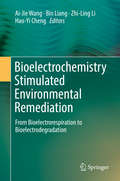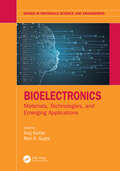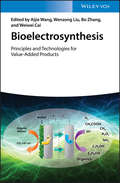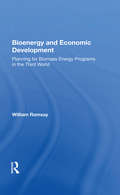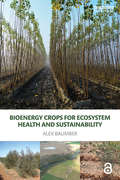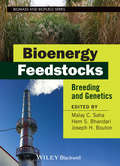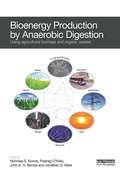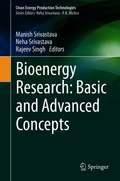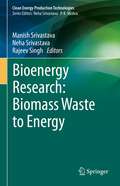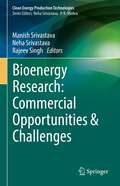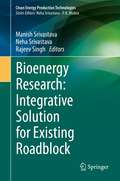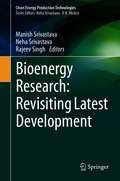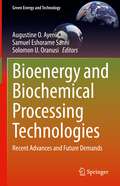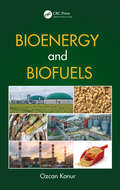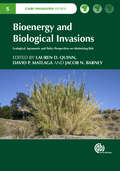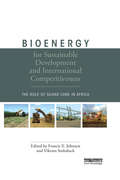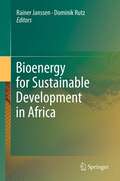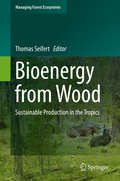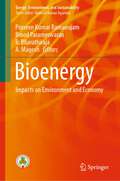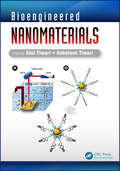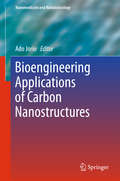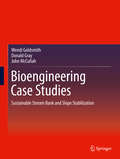- Table View
- List View
Bioelectrochemistry Stimulated Environmental Remediation: From Bioelectrorespiration to Bioelectrodegradation
by Bin Liang Ai-Jie Wang Zhi-Ling Li Hao-Yi ChengThis book reviews the latest advances in the bioelectrochemical degradation of recalcitrant environmental contaminants. The first part introduces readers to the basic principles and methodologies of bioelectrochemical systems, electron-respiring microorganisms, the electron transfer mechanism and functional electrode materials. In turn, the second part addresses the bioelectrochemical remediation/treatment of various environmental pollutants (including highly toxic refractory organics, heavy metals, and nitrates) in wastewater, sediment and wetlands. Reactor configuration optimization, hybrid technology amplification and enhanced removal principles and techniques are also discussed.The book offers a valuable resource for all researchers and professionals working in environmental science and engineering, bioelectrochemistry, environmental microbiology and biotechnology.
Bioelectromagnetism: History, Foundations and Applications
by Shoogo UenoBioelectromagnetism has been gradually developing and expanding into a variety of fields in engineering, biomedical engineering, life science, medicine and biology. Bioelectromagnetism: History, Foundations and Applications provides an overview of the field and its developments; from its inception and growth through the twenty-first century, to the latest advances in electro- and magnetobiology and hazard evaluations of electromagnetic fields.It is organized into three sections, each focusing on specific regions of bioelectromagnetism. It begins with the foundations of the field and its history, with a chronological treatment of the major subjects in bioelectromagnetism. The relationship between atmospheric electromagnetic phenomena, geomagnetism and biological systems are presented. It then discusses the many benefits of bioelectromagnetism: electroreception, magnetic navigation, magnetic sense and magnetic responses of plants, birds, animals and humans. It then moves on to human health issues and the impact of bioelectromagnetism. It also provides practical guidance on how to set safety guidelines. Finally, it looks forward to the future prospects of the field based on the latest research in the field.In exploring both the history of the field and the latest developments in today’s research advances, this book provides a comprehensive and self-contained treatment on the subject, which will be a valuable reference for researchers in biophysics, medicine, electrical engineering and biomedical engineering.It can be used as a companion to the editor’s previously published books: Biomagnetics: Principles and Applications of Biomagnetic Stimulation and Imaging (9781482239201, 2016, CRC Press); and Bioimaging: Imaging by Light and Electromagnetics in Medicine and Biology (9780367203047, 2020, CRC Press).Key Features: Provides both a historical view of the field, along with the latest developments in the field Contains practical guidance for researchers on how to set safety guidelines for those working in the area Edited by authorities in the field, with chapter contributions from specialists
Bioelectronics: Materials, Technologies, and Emerging Applications (Series in Materials Science and Engineering)
by Anuj Kumar Ram K. GuptaBioelectronics is emerging as a new area of research where electronics can selectively detect, record, and monitor physiological signals. This is a rapidly expanding area of medical research, that relies heavily on multidisciplinary technology development and cutting-edge research in chemical, biological, engineering, and physical science. This book provides extensive information on the (i) fundamental concepts of bioelectronics, (ii) materials for the developments of bioelectronics such as implantable electronics, self-powered devices, bioelectronic sensors, flexible bioelectronics, etc, and (iii) an overview of the trends and gathering of the latest bioelectronic progress. This book will broaden our knowledge about newer technologies and processes used in bioelectronics.
Bioelectrosynthesis: Principles and Technologies for Value-Added Products
by Bo Zhang Aijie Wang Wenzong Liu Weiwei CaiIntroduces basic principles and mechanisms, covers new developments, and provides a different view of the main facets of bioelectrosynthesis Bioelectrosynthesis represents a promising approach for storing renewable energy or producing target chemicals in an energy-sustainable and low-cost way. This timely and important book systemically introduces the hot issues surrounding bioelectrosynthesis, including potential value-added products via bioelectrochemical system, reactor development of bioelectrosynthesis, and microbial biology on biofilm communities and metabolism pathways. It presents readers with unique viewpoints on basic principles and mechanisms along with new developments on reactor and microbial ecology. Beginning with a principle and products overview of bioelectrosynthesis, Bioelectrosynthesis: Principles and Technologies for Value-Added Products goes on to offer in-depth sections on: biogas production and upgrading technology via bioelectrolysis; organic synthesis on cathodes; chemical products and nitrogen recovery; external electron transfer and electrode material promotion; and the microbiology of bioelectrosynthesis. Topics covered include: hydrogen production from waste stream with microbial electrolysis cell; microbial electrolysis cell; inorganic compound synthesis in bioelectrochemical system; microbial growth, ecological, and metabolic characteristics in bioelectrosynthesis systems; microbial metabolism kinetics and interactions in bioelectrosynthesis system; and more. * Comprehensively covers all of the key issues of biolelectrosynthesis * Features contributions from top experts in the field * Examines the conversion of organic wastes to methane via electromethanogenesis; methane production at biocathodes; extracellular electron transport of electroactive biofilm; and more Bioelectrosynthesis: Principles and Technologies for Value-Added Products will appeal to chemists, electrochemists, environmental chemists, water chemists, microbiologists, biochemists, and graduate students involved in the field.
Bioenergy And Economic Development: Planning For Biomass Energy Programs In The Third World
by William C RamsayBioenergy, a promising alternative for developing countries, is already a key resource (in the form of fuelwood, for example) in millions of households around the world. Third World planners are exploring new technologies and uses, including the production of biogas from wastes for household cooking, the burning of wood chips under boilers to produ
Bioenergy Crops for Ecosystem Health and Sustainability (Routledge Studies in Bioenergy)
by Alex BaumberThe growing of crops for bioenergy has been subject to much recent criticism, as taking away land which could be used for food production or biodiversity conservation. This book challenges some commonly-held ideas about biofuels, bioenergy and energy cropping, particularly that energy crops pose an inherent threat to ecosystems, which must be mitigated. The book recognises that certain energy crops (e.g. oil palm for biodiesel) have generated sustainability concerns, but also asks the question "is there a better way?" of using energy crops to strategically enhance ecosystem functions. It draws on numerous case studies, including where energy crops have had negative outcomes as well as well as cases where energy crops have produced benefits for ecosystem health, such as soil and water protection from the cropping of willow and poplar in Europe and the use of mallee eucalypts to fight salinity in Western Australia. While exploring this central argument, the volume also provides a systematic overview of the socio-economic sustainability issues surrounding bioenergy.
Bioenergy Crops: A Sustainable Means of Phytoremediation
by Jos T. PuthurBioenergy Crops: A Sustainable Means of Phytoremediation comprises a unique combination of topics related to the field of phytoremediation and bioenergy production. It highlights the future face of industries in phytoremediation and bioenergy production. The book deals with most promising plant and alga species for biomass production and phytoremediation. It deals with constructed wetlands, bioremediation and microbial fuel cells with case studies of phytoremediation and bioenergy production. The comprehensive knowledge on the dual aspects of hyperaccumulators in phytoremediation and bioenergy production guides graduates, post-graduates as well as researchers to know the latest updates in the field. Key Features:• Presents dual aspects of hyperaccumulators in phytoremediation and bioenergy production.• Highlights the future face of industries in phytoremediation and bioenergy production.• Focuses the promising candidates exploits as hyperaccumulator and biomass producers.• Explains the role of algae and microbes in bioremediation and bioenergy production.• Represents a comprehensive, up-to-date analysis in the field of phytoremediation as well as bioenergy production.
Bioenergy Feedstocks
by Hem S. Bhandhari Malay C. Saha Joseph H. BoutonBioenergy and biofuels are generated from a wide variety of feedstock. Fuels have been converted from a wide range of sources from vegetable oils to grains and sugarcane. Second generation biofuels are being developed around dedicated, non-food energy crops, such as switchgrass and Miscanthus, with an eye toward bioenergy sustainability. Bioenergy Feedstocks: Breeding and Genetics looks at advances in our understanding of the genetics and breeding practices across this diverse range of crops and provides readers with a valuable tool to improve cultivars and increase energy crop yields.Bioenergy Feedstocks: Breeding and Genetics opens with chapters focusing primarily on advances in the genetics and molecular biology of dedicated energy crops. These chapters provide in-depth coverage of new, high-potential feedstocks. The remaining chapters provide valuable overview of breeding efforts of current feedstocks with specific attention paid to the development of bioenergy traits. Coverage in these chapters includes crops such as sorghum, energy canes, corn, and other grasses and forages.The final chapters explore the role of transgenics in bioenergy feedstock production and the development of low-input strategies for producing bioenergy crops. A timely collection of work from a global team of bioenergy researchers and crop scientists, Bioenergy Feedstocks: Breeding and Genetics is an essential reference on cultivar improvement of biomass feedstock crops.
Bioenergy Production by Anaerobic Digestion: Using Agricultural Biomass and Organic Wastes (Routledge Studies in Bioenergy)
by Nicholas E. Korres Padraig O'Kiely John A.H. Benzie Jonathan S. WestInterest in anaerobic digestion (AD), the process of energy production through the production of biogas, has increased rapidly in recent years. Agricultural and other organic waste are important substrates that can be treated by AD. This book is one of the first to provide a broad introduction to anaerobic digestion and its potential to turn agricultural crops or crop residues, animal and other organic waste, into biomethane. The substrates used can include any non-woody materials, including grass and maize silage, seaweeds, municipal and industrial wastes. These are all systematically reviewed in terms of their suitability from a biological, technical and economic perspective. In the past the technical competence and high capital investment required for industrial-scale anaerobic digesters has limited their uptake, but the authors show that recent advances have made smaller-scale systems more viable through a greater understanding of optimising bacterial metabolism and productivity. Broader issues such as life cycle assessment and energy policies to promote AD are also discussed.
Bioenergy Research: Basic and Advanced Concepts (Clean Energy Production Technologies)
by Neha Srivastava Manish Srivastava Rajeev SinghThis volume is first part of the five-part set on bioenergy research. This volume covers current developments and both basic and advanced concepts in bioenergy production. Based on bioenergy road map, the book will also evaluate about the ratio existing between current challenges associated and practical implementation of these biofuels. The book complies up to-date progressive development in available bioenergy options and discusses opportunities and existing risks. The main objective of the book is to provide insights into the opportunities and required actions for the development of an economically viable bioenergy industry for practical replacement of fossil fuels. This book is of interest to teachers, researchers, scientists, capacity builders and policymakers. Also the book serves as additional reading material for undergraduate and graduate students of environmental sciences. National and international bioenergy scientists, policy makers will also find this to be a useful read. Other four volumes of this set explore latest developments, commercial opportunities, waste to energy and integrated solution for bioenergy concerns.
Bioenergy Research: Biomass Waste to Energy (Clean Energy Production Technologies)
by Neha Srivastava Manish Srivastava Rajeev SinghThis volume is fourth part of the five-part set on bioenergy research. This volume covers biomass to bioenergy production concept. The book is focused on the possible and versatile biomass options available for the generation of bioenergy. Additionally, the book also explores different types of biomass for bioenergy generation at a commercial level. Further, the book elaborates on different kind of cellulose and sugar rich waste which can also be utilized for bioenergy production. It covers other relevant issues such as recent technological advancement in biomass to bioenergy conversion, waste management in the context of biomass to biofuels production technologies, green methods of energy production, alternates of fossil fuels in the near future. It also explores biomass waste valorization, utilizing microbial processes in bioenergy production. This is a useful reading material for students, researchers, industry and policy experts.Other four volumes of this set explore basic concepts, latest progress, commercial opportunities and integrated solution for bioenergy concerns.
Bioenergy Research: Commercial Opportunities & Challenges (Clean Energy Production Technologies)
by Neha Srivastava Manish Srivastava Rajeev SinghThis volume is third part of the five-part set on bioenergy research. This book provides insights into commercial advantages of commonly running bioenergy options. It explores various opportunities present at technical scale to produce biofuels. Moreover, the additional practical feasibility of the commercialization of existing biofuels including existing challenges and sustainable solutions to overcome from these technical hurdles. This Volume also focuses on the durability and long run sustainability on the new arrival of biofuels options which can be a suitable and easy replacement of currently available biofuels at pilot scale. Other four volumes of this set explore basic concepts, latest progress, bio-waste to energy conversion and integrated solution for bioenergy concerns.
Bioenergy Research: Integrative Solution for Existing Roadblock
by Neha Srivastava Manish Srivastava Rajeev SinghThis volume is fifth part of the five-part set on bioenergy research. This edited volume provides sustainable solution for all existing roadblocks in commercial bioenergy production. The book focuses on different types of obstacles involved in various bioenergy operations with detail remedy of the issue in a sustainable way. In spite of having number of potential advantages, all available bioenergy options are still far from smooth practical applicability, due to which they are still in pipeline phase to replace the fossil fuels. This book brings together the integrative approach to the readers, to connect with more viable bioenergy type on commercial scale, the existing issues and the feasible approaches to eliminate the bottlenecks in the process. Further, the book also uncovers the untouched area of bioenergy production technology by bringing forth unconventional methods, processes and parameters, which have scope to enhance biofuel production technology by “Lab to Land” methods. The book highlights aspect which are less studied or are very new in their industrial application of bioenergy production. The book presents relevant reading material for global researchers, academic institutions, research students, teachers, scientist as well as industries. Other four volumes of this set explore basic concepts, latest progress, commercial opportunities and bio-waste to energy conversion.
Bioenergy Research: Revisiting Latest Development (Clean Energy Production Technologies)
by Neha Srivastava Manish Srivastava Rajeev SinghThis volume is second part of the five-part set on bioenergy research. This book provides new insight about the latest development in bioenergy research. It presents the various bioenergy options which are further explored for practical viability, their progress and utility in the industry. The main objective of the book is to provide insights into the opportunities and required actions for the development of an economically viable bioenergy industry for practical replacement of fossil fuels. This book is of interest to teachers, researchers, scientists, capacity builders and policymakers. Also the book serves as additional reading material for undergraduate and graduate students of environmental sciences. National and international bioenergy scientists, policy makers will also find this to be a useful read. Other four volumes of this set explore basic concepts, commercial opportunities, waste to energy and integrated solution for bioenergy concerns.
Bioenergy and Biochemical Processing Technologies: Recent Advances and Future Demands (Green Energy and Technology)
by Augustine O. Ayeni Samuel Eshorame Sanni Solomon U. OranusiThis book presents novel techniques, current trends, and cutting-edge technologies in energy and biochemical processes. The authors explore recent advances that solve challenges related to the implications and commercialization of these processes by introducing new techniques or modifying existing technologies to meet future demands for food materials, bioproducts, fossil fuels, biofuels, and bioenergy. Divided into three parts, the first section of the book addresses issues related to the utilization and management of energy towards the efficient characterization and conversion of wastes or raw-/bio- materials to useful products. The second section focuses largely on studies on molecular detection of analytes, purification, and characterization of products recovered from biochemical, enzymatic, food, and phytochemicals, as well as biostimulation and bioaugmentation processes. The final section discusses areas related to heat and mass transfer, fuel processing technologies, nanofluids, and their applications.
Bioenergy and Biofuels
by Ozcan KonurThis book aims to inform readers about the recent developments in bioenergy and biofuels covering current issues from an interdisciplinary approach. It will also feature coverage of anticipated future trends related to each particular biofuel. Chapters will consist of original research presented by world class experts in their respective fields. A number of interdisciplinary areas will be incorporated such as Energy & Fuels, Biotechology, Genomics, Economics, Optimization, Chemical Engineering, Mechanical Engineering and Algae Science. Examples will relate to a matrix of biofuel and energy types such as bioethanol, biobutanol, and biomethane.
Bioenergy and Biological Invasions
by Rachel Bethke Carol Mallory-Smith Russell Jessup Jacob N Barney Stephen F Enloe Caroline E Ridley Phang Siew Moi Larissa Smith Bryan Endres Lauren D Quinn Lloyd Nackley David MatlagaDespite major international investment in biofuels, the invasive risks associated with these crops are still unknown. A cohesive state-of-the-art review of the invasive potential of bioenergy crops, this book covers the identified risks of invasion, distributions of key crops and policy and management issues. Including a section on developing predictive models, this book also assesses the potential societal impact of bioenergy crops and how to mitigate invasive risks.
Bioenergy and Biological Invasions: Ecological, Agronomic and Policy Perspectives on Minimizing Risk (Plant Science / Horticulture Ser. #5)
by Rachel Bethke Carol Mallory-Smith Russell Jessup Stephen F Enloe Caroline E Ridley Phang Siew Moi Larissa Smith Bryan Endres Lloyd NackleyDespite major international investment in biofuels, the invasive risks associated with these crops are still unknown. A cohesive state-of-the-art review of the invasive potential of bioenergy crops, this book covers the identified risks of invasion, distributions of key crops and policy and management issues. Including a section on developing predictive models, this book also assesses the potential societal impact of bioenergy crops and how to mitigate invasive risks.
Bioenergy for Sustainable Development and International Competitiveness: The Role of Sugar Cane in Africa
by Francis X. JohnsonGrowing concerns about the impacts of climate change and dependence on fossil fuels have intensified interest in bioenergy from sugar cane and other crops, highlighting important links between energy, environment and development goals. Sub-Saharan Africa is characterized by severe poverty; the possibility to exploit a renewable energy resource offers valuable avenues for sustainable development and could support a more dynamic and competitive economy. This book describes how the bioenergy expansion will improve rural livelihoods, reduce costly energy imports, reduce GHG emissions, and offer new development paths. Drawing on international experience, it is shown that harnessing this potential will require significant increases in investment, technology transfer, and international cooperation. Because of its high efficiency, the authors argue that sugar cane should be viewed as a global resource for sustainable development and should command much greater focus and concerted policy action. Through an analysis of the agronomy, land suitability and industrial processing of sugar cane and its co-products, along with an assessment of the energy, economic and environmental implications, this volume demonstrates that sugar cane offers a competitive and environmentally beneficial resource for Africa's economic development and energy security. With forty-four authors representing thirty organisations in sixteen countries, the book offers a truly international and interdisciplinary perspective by combining technical and economic principles with social, political and environmental assessment and policy analysis.
Bioenergy for Sustainable Development in Africa
by Dominik Rutz Rainer JanssenThe work builds on the results of the COMPETE Bioenergy Competence Platform for Africa, which was supported by the European Commission and coordinated by WIP Renewable Energies, Germany. The five sections cover biomass production and use, biomass technologies and markets in Africa, biomass policies, sustainability, and financial and socio-economic issues. This valuable work is, in effect, a single-source treatment of a key energy sector in a part of the world which still has a lot of unrealised potential for development.
Bioenergy from Wood: Sustainable Production in the Tropics (Managing Forest Ecosystems #26)
by Thomas SeifertThis book is written for scientists and practitioners interested in deepening their knowledge of the sustainable production of bioenergy from wood in tropical and sub-tropical countries. Utilising the value chain concept, this book outlines the necessary aspects for managing sustainable bioenergy production. A wide range of topics is covered including biomass localization, modelling and upscaling, production management in woodlands and plantations, and transport and logistics. Biomass quality and conversion pathways are examined in order to match the conversion technology with the available biomass. A section is dedicated to issues surrounding sustainability. The issues, covered in a life-cycle assessment of the bioenergy system, include socio-economic challenges, local effects on water, biodiversity, nutrient-sustainability and global impacts. Through this holistic approach and supporting examples from tropical and sub-tropical countries, the reader is guided in designing and implementing a value chain as the main management instrument for sustainable wood.
Bioenergy: Impacts on Environment and Economy (Energy, Environment, and Sustainability)
by Binod Parameswaran B. Bharathiraja Praveen Kumar Ramanujam A. MageshThis contributed volume discusses the impact of bioenergy on the environment and economy. The book contents include contributions on themes, such as the impact of emulsified biofuels on the environment, environmental impacts of the current uses of biomass energy, sustainable development in ecosystem, trends in microbial fuel cells and the ecological and economic impacts on biofuel production, among others. The book also uses visual elements to aid learning. This book is a valuable, hands-on resource for researchers, academics and industry professionals, who are interested in alternative fuels, sustainability, clean energy, biofuel production, waste management, environmental pollution, renewable energy and allied fields.
Bioengineered Nanomaterials
by Atul Tlwarl Ashutosh TlwarlMany varieties of new, complex diseases are constantly being discovered, which leaves scientists with little choice but to embrace innovative methods for controlling the invasion of life-threatening problems. The use of nanotechnology has given scientists an opportunity to create nanomaterials that could help medical professionals in diagnosing and
Bioengineering Applications of Carbon Nanostructures (Nanomedicine and Nanotoxicology)
by Ado JorioThis book covers the development of biotechnology based on carbon nanostructures, with a focus on nanotubes, addressing also fullerenes and amorphous carbons. The book is divided into 7 chapters, addressing tissue engineering, genetic engineering and therapy, as well as the environmental and health impacts of carbon nanostructures.
Bioengineering Case Studies: Sustainable Stream Bank and Slope Stabilization
by Wendi Goldsmith Donald Gray John Mccullah"Bio-Stabilization Case Studies: Treatment and Performance Evaluation" describes and evaluates 30 projects from across the United States where bio-stabilization was employed to address a detrimental naturally occurring process or byproduct of the built environment. Bio-stabilization (or soil bioengineering) refers to the use of plant materials, primarily live cuttings, arranged in the ground in different arrays to reinforce soils and protect upland slopes and/or stream banks against surficial erosion and shallow slope failures. Examples included in the collection represent different regions of the country and their specific conditions and challenges. Each project is illustrated with a number of distinctive photographs to support the reader's understanding and showcase the wide scope of projects and techniques presented. The volume is ideal for civil and environmental engineers and environmental scientists working on watershed, infrastructure projects, and municipal scale installations.
